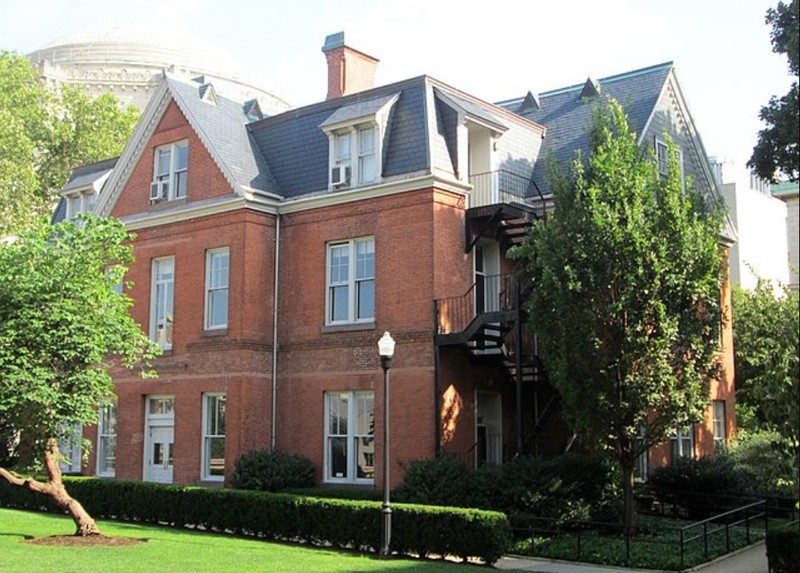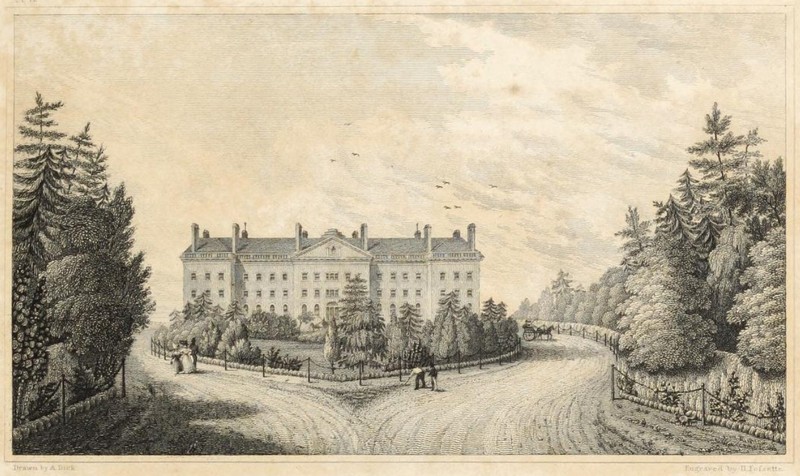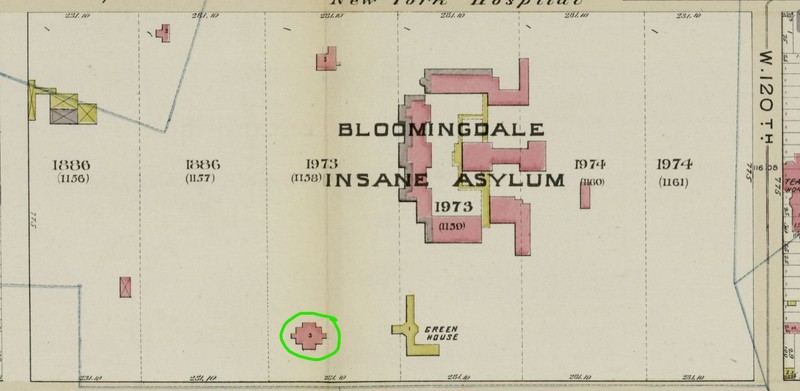Macy Villa (Buell Hall)
Introduction
Text-to-speech Audio
Buell Hall, the brick building to the southeast of Columbia University's Low Library. is the oldest building on the Morningside Heights campus and is actually older than the campus. Columbia College bought the land for their new campus in Morningside Heights from New York Hospital in 1892. Prior to then, the property was the site of the Bloomingdale Insane Asylum, a hospital for the mentally ill. "Macy Villa" was built in 1885 to house wealthy male patients in more comfortable surroundings, apart from the general population of the asylum. Macy Villa was moved uphill to this spot from nearby in 1905 to make room for a new campus building (Kent Hall); the house's front porch was not rebuilt. Since 1977, Buell Hall has housed the Maison Francaise, founded at Columbia in 1913 as the first center for study of French civilization and literature to be established at an American university. Offices of several architectural institutes are in Buell Hall as well.
Images
Buell Hall (originally Macy Villa) on Columbia U. campus in 2014 photo (Beyond My Ken)

"Lunatic Asylum (Manhattanville)" engraving of 1820 building in 1831 book (drawn by A. Dick & H. Fossette)

Macy Villa (green) on Bloomingdale Insane Asylum grounds on 1894 map (Bromley p. 38)

Backstory and Context
Text-to-speech Audio
The Bloomingdale Insane Asylum, a branch of the New York Hospital, was established in the late 1810s on one of the highest spots on the island, seven miles north of the developed part of Manhattan. A farm of about 55 acres in "Manhattanville" (now Morningside Heights), east of Bloomingdale Road, was purchased to build the new asylum. The farm property replaced the original "Lunatic Asylum," a stone structure constructed in Lower Manhattan in 1808 near the public hospital that had opened in 1791. The asylum housed 67 patients in 1808 and was headed by Dr. Archibald Bruce. The cornerstone of the new building on the farmland was laid in 1818 and, in mid-1821, the first 52 patients moved in from the old asylum. The new building was planned by one of its directors, Thomas C. Taylor. Laban Gardner was the first Superintendent, and his wife was the first Matron. Dr. James Eddy was the first Resident Physician; the first Attending Physician, required to visit teach patient twice per week, was Dr. John Neilson. The state spent $200,000 in land and building costs for the three-story plus basement, red New Jersey sandstone structure. The building was organized with a central portion for the superintendent, his family, physicians, and other staff. Wings on either end were reserved for male or female patients. The institution received $10,000 annually from the New York State Legislature; the institution was the only one of its kind in New York State at the time. Population was capped at 200 residents. Treatment involved "agricultural and mechanical occupations" with residents encouraged to read, draw, or exercise in the sunshine of the gardens and deer-filled meadows. Two more three-story residential buildings were added to the asylum in its first decades: one for men in 1829 and one for women in 1837. By the mid-1840s, other outbuildings on the grounds included a large stone barn (with stables and a carriage house), a greenhouse or conservatory containing 700 plants, and an icehouse.
To make the living circumstances for wealthy, male mental patients at the Bloomingdale Insane Asylum more pleasant, William H. Macy (no, not the actor) donated funds to build a standalone house on the grounds. Macy (1805-1887) was a former bank president who served as President of the New York Hospital and the Bloomingdale Asylum. "Macy Villa" is a three-story brick building that served its purpose while part of the asylum, but was not as well suited to being an academic building after becoming the property of Columbia University. Early occupants of the campus building were athletes in the Columbia Rowing Committee, who planned to move into rooms in Macy Villa on March 15, 1895. The training crews also moved into the house for the season in 1896 and 1897.
The new campus of Columbia U. opened in October 1897, while construction of new buildings was still underway. Undergraduate students of Columbia College complained in 1898 about being relegated to Macy Hall, while the graduate students of Columbia University were afforded spacious, newly-built buildings with separate libraries for graduate schools of law, engineering, and other disciplines. Macy Hall was described in a local newspaper as "a three-story, old red brick building with small, badly-arranged rooms" in the southeast corner of Columbia's new grounds. A professor deemed Macy Hall to be "conspicuous by its insignificance and suggestive of indifference or disdain...not dignified...not worthy of the college, its history, its reputation, its present high state of efficiency." Within Macy Hall, courses in Greek, Latin, and mathematics were taught, and the college dean, Dean Van Amridge, had office space. Other undergraduate departments were scattered about the campus in various buildings. Undergraduates complained of having no room to congregate, unlike the smoking room reserved for Law School men, and called for construction of a new College Hall. An undergraduate student likened their situation on campus to being "homeless outcasts."
The building was renamed several more times, to College Hall, East Hall, and finally to Buell Hall in 1983 to honor alumnus and donor Temple Hoyne Buell.
Sources
Anonymous. "Obituary. William H. Macy." The Sun (New York) May 20th 1887. 1-1.
Anonymous. "Among the Colleges: Columbia." New-York Tribune (New York) March 3rd 1895. 18-18.
Anonymous. "Among the Colleges: Columbia." New-York Tribune (New York) September 27th 1897. 10-10.
Anonymous. "Athletics. Columbia Students Rapidly Getting into Form." The Sun (New York) April 5th 1897. 10-10.
Anonymous. "Discontent at Columbia." The Sun (New York) February 27th 1898. 3-3.
Columbia University. Guided Walking Tour of Columbia University Campus, Columbia University: Tours. Accessed October 11th 2021. https://visit.columbia.edu/sites/default/content/Final%20VC%20updated%20walking-tour-and-map.pdf.
Dakin, Architect. Fay, Theodore S. Views in New York And its Environs from Accurate, Characteristic & Picturesque Drawings. New York, NY. Peabody & Co., 1831.
Earle, Pliny , M.D. History, Description and Statistics of the Bloomingdale Asylum for the Insane. New York, NY. Egbert, Hovey & King, 1848.
Jacobovitz, Gavrielle. Buell Hall's Hidden History. Columbia Spectator. December 6th 2016.
https://en.wikipedia.org/wiki/Buell_Hall#/media/File:2014_Columbia_University_Buell_Hall.jpg
Dakin & Fay 1831, p. 45. https://archive.org/details/viewsinnewyorkit00fayt/mode/1up
Library of Congress (LOC): https://www.loc.gov/item/2010587355/
